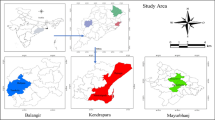Abstract
Participation in the U.S. Federal Crop Insurance Program (FCIP) has increased over time at both extensive (insured acres) and intensive (coverage level) margins, but there are clear spatio-temporal variations in these trends. Farmers’ decisions are likely influenced by recent indemnity or weather experiences (i.e., recency effects). We develop a model to identify two channels through which recent adverse weather experiences may affect participation, one where the weather shocks directly affect participation and the other where they affect participation through indemnity payouts. With historic FCIP data over the period 2001–2017, we use parametric and non-parametric methods to estimate these effects. At both extensive and intensive margins, higher past indemnities are found to encourage participation. This provides evidence that prior adverse weather shocks work indirectly. Less evidence is found in favour of direct weather effects. We also find that the increase in participation due to indemnities peaks in the year following a loss.










Similar content being viewed by others
Notes
Detailed data are available at https://legacy.rma.usda.gov/data/sob.html.
Indemnity ratio, as defined above, depends on intensive margin choices. All else being equal, the indemnification rate will be higher when the average coverage level is higher.
The 12 states are Iowa, Illinois, Indiana, Kansas, Michigan, Minnesota, Missouri, North Dakota, Nebraska, Ohio, South Dakota and Wisconsin.
More generally, insurance studies have typically covered either the intensive margin or the extensive margin but not both. See analysis by Geruso et al. (2019), on equilibrium under adverse selection for reasoning on why considering these margins separately may be problematic.
Detailed data set variable lists are available at https://www.rma.usda.gov/-/media/RMAweb/SCC-SOB/State-County-Crop-Coverage/sobsccc_1989forward-pdf.ashx?la=en.
Detailed data set variable lists are available at https://www.rma.usda.gov/SummaryOfBusiness/CauseOfLoss.
Detailed data are available at https://quickstats.nass.usda.gov/.
The conversions are 10 °C = 50 °F, 30 °C = 86 °F, 32.2 °C = 90 °F.
Detailed data are available at https://www1.ncdc.noaa.gov/pub/data/cirs/climdiv/, accessed on 06 September 2018.
References
Bakkensen, L.A., X. Ding, and L. Ma. 2019. Flood risk and salience: New evidence from the Sunshine State. Southern Economic Journal 85 (4): 1132–1158. https://doi.org/10.1002/soej.12327.
Bjerge, B., and N. Trifkovic. 2018. Extreme weather and demand for index insurance in rural India. European Review of Agricultural Economics 45 (3): 397–431. https://doi.org/10.1093/erae/jbx037.
Cai, J., and C. Song. 2017. Do disaster experience and knowledge affect insurance take-up decisions? Journal of Development Economics 124: 83–94. https://doi.org/10.1016/j.jdeveco.2016.08.007.
Cai, J., A. De Janvry, and E. Sadoulet. 2015. Social networks and the decision to insure. American Economic Journal: Applied Economics. 7(2): 81–108. https://www.aeaweb.org/articles?id=10.1257/app.20130442. Accessed 26 November 2018.
Cai, J., A. De Janvry, and E. Sadoulet. 2016. Subsidy policies and insurance demand (No. w22702). National Bureau of Economic Research. https://doi.org/10.3386/w22702.
Camerer, C.F., and G. Loewenstein. 2011. Behavioral economics: Past, present, future. In Advances in behavioral economics, ed. C.F. Camerer, G. Loewenstein, and M. Rabin, 3–51. Princeton: Princeton University Press.
Chong, H., and J. Ifft. 2016. (Over)reacting to bad luck: Low yields increase crop insurance participation. In Presentation at SCC-76 2016 annual meeting, “Economics and Management of Risks in Agriculture and Natural Resources”, March 17–19, 2016, Pensacola Beach, FL. http://docplayer.net/1710422-Over-reacting-to-bad-luck-low-yields-increase-crop-insurance-participation-howard-chong-jennifer-ifft.html. Accessed 7 September 2016.
Du, X., H. Feng, and D.A. Hennessy. 2017. Rationality of choices in subsidized crop insurance markets. American Journal of Agricultural Economics 99 (3): 732–756. https://doi.org/10.1093/ajae/aaw035.
Du, X., D.A. Hennessy, and H. Feng. 2014. A natural resource theory of US crop insurance contract choice. American Journal of Agricultural Economics 96 (1): 232–252. https://doi.org/10.1093/ajae/aat057.
Fredrickson, B.L., and D. Kahneman. 1993. Duration neglect in retrospective evaluations of affective episodes. Journal of Personality and Social Psychology 65 (1): 45–55. https://doi.org/10.1037/0022-3514.65.1.45.
Gallagher, J. 2014. Learning about an infrequent event: Evidence from flood insurance take-up in the United States. American Economic Journal: Applied Economics 6 (3): 206–233. https://doi.org/10.1257/app.6.3.206.
Geruso, M., T.J. Layton, G. McCormack, and M. Shepard. 2019. The two margin problem in insurance markets. Unpublished working paper. https://papers.ssrn.com/sol3/papers.cfm?abstract_id=3385492. Accessed 1 June 2019.
Glauber, J.W. 2004. Crop insurance reconsidered. American Journal of Agricultural Economics 86(5): 1179–1195. http://www.jstor.org/stable/3697927. Accessed 11 May 2019.
Goodwin, B.K., M.L. Vandeveer, and J.L. Deal. 2004. An empirical analysis of acreage effects of participation in the federal crop insurance program. American Journal of Agricultural Economics 86(4): 1058–1077. http://www.jstor.org/stable/4492792. Accessed 24 May 2017.
Hanaoka, C., H. Shigeoka, and Y. Watanabe. 2018. Do risk preferences change? Evidence from the Great East Japan Earthquake. American Economic Journal: Applied Economics 10(2): 298–330. https://www.aeaweb.org/articles?id=10.1257/app.20170048. Accessed 28 May 2019.
Heim Jr., R.R. 2002. A review of twentieth-century drought indices used in the United States. Bulletin of the American Meteorological Society 83 (8): 1149–1166. https://doi.org/10.1175/1520-0477-83.8.1149.
Just, R.E., L. Calvin, and J. Quiggin. 1999. Adverse selection in crop insurance: Actuarial and asymmetric information incentives. American Journal of Agricultural Economics 81 (4): 834–849. https://doi.org/10.2307/1244328.
Kousky, C. 2017. Disasters as learning experiences or disasters as policy opportunities? Examining flood insurance purchases after hurricanes. Risk Analysis 37 (3): 517–530. https://doi.org/10.1111/risa.12646.
Kramer, R.A. 1983. Federal crop insurance, 1938–1982. Agricultural History 57(2): 181–200. https://www.jstor.org/stable/3743155. Accessed 11 May 2019.
Kunreuther, H.C., M.V. Pauly, and S. McMorrow. 2013. Insurance and behavioral economics: Improving decisions in the most misunderstood industry. Cambridge: Cambridge University Press.
Makki, S.S., and A. Somwaru. 2001. Farmers’ participation in crop insurance markets: Creating the right incentives. American Journal of Agricultural Economics 83(3): 662–667. https://www.jstor.org/stable/1245096. Accessed 28 March 2019.
Manski, C.F. 1993. Identification of endogenous social effects: The reflection problem. Review of Economic Studies 60 (3): 531–542. https://doi.org/10.2307/2298123.
Menne, M.J., I. Durre, B. Korzeniewski, S. McNeal, K. Thomas, X. Yin, S. Anthony, R. Ray, R.S. Vose, B.E.Gleason, and T.G. Houston. 2012. Global Historical Climatology Network - Daily (GHCN-Daily), Version 3. NOAA National Climatic Data Center. https://doi.org/10.7289/V5D21VHZ. Accessed 6 Oct 2018.
Mossin, J. 1968. Aspects of rational insurance purchasing. Journal of Political Economy 76 (4): 553–568. https://doi.org/10.1086/259427.
O’Donoghue, E. 2014. The effects of premium subsidies on demand for crop insurance (No. 178405). U.S. Department of Agriculture (USDA), Economic Research Service (ERS). http://doi.org/10.2139/ssrn.2502908.
Papke, L.E., and J.M. Wooldridge. 1996. Econometric methods for fractional response variables with an application to 401(k) plan participation rates. Journal of Applied Econometrics 11 (6): 619–632. https://doi.org/10.1002/(SICI)1099-1255(199611)11:6%3C619:AID-JAE418%3E3.0.CO;2-1.
Pétraud, J., S. Boucher, and M. Carter. 2015. Competing theories of risk preferences and the demand for crop insurance: Experimental evidence from Peru. In Paper presented at the 2015 conference, August 9–14, 2015, Milan, Italy. International Association of Agricultural Economists. https://ageconsearch.umn.edu/record/211383. Accessed 11 January 2017.
Pratt, J.W. 1964. Risk aversion in the small and in the large. Econometrica 32 (1–2): 122–136. https://doi.org/10.2307/1913738.
Price, M., C.L. Yu, D.A. Hennessy, and X. Du. 2019. Are actuarial crop insurance rates fair? An analysis using a penalized bivariate B-spline method. Journal of the Royal Statistical Society Series C Applied Statistics. https://doi.org/10.1111/rssc.12363.
Ramirez, O.A., and J.S. Shonkwiler. 2017. A probabilistic model of the crop insurance purchase decision. Journal of Agricultural and Resource Economics 42 (1): 10–26.
Royal, A., and M. Walls. 2019. Flood risk perception and insurance choice: Do decisions in the Floodplain reflect overoptimism? Risk Analysis 39 (5): 1088–1104. https://doi.org/10.1111/risa.13240.
Santeramo, F.G. 2019. I learn, you learn, we gain experience in crop insurance markets. Applied Economic Perspectives and Policy 41 (2): 284–304. https://doi.org/10.1093/aepp/ppy012.
Schildberg-Hörisch, H. 2018. Are risk preferences stable? Journal of Economic Perspectives 32 (2): 135–154. https://doi.org/10.1257/jep.32.2.135.
Schreiber, C.A., and D. Kahneman. 2000. Determinants of the remembered utility of aversive sounds. Journal of Experimental Psychology: General 129 (1): 27–42. https://doi.org/10.1037/0096-3445.129.1.27.
Sherrick, B.J., P.J. Barry, P.N. Ellinger, and G.D. Schnitkey. 2004. Factors influencing farmers’ crop insurance decisions. American Journal of Agricultural Economics 86 (1): 103–114. https://doi.org/10.1111/j.0092-5853.2004.00565.x.
Shields, D.A. 2015. Federal crop insurance: Background. Congressional Research Service, 7-5700.
Stein, D. 2016. Dynamics of demand for rainfall index insurance: Evidence from a commercial product in India. The World Bank Economic Review 32(3): 692–708. https://ssrn.com/abstract=2497235. Accessed 26 November 2018.
Sutton, R.S., and A.G. Barto. 2018. Reinforcement learning: An introduction, 2nd ed. Cambridge: MIT Press.
Xu, Z., D.A. Hennessy, K. Sardana, and G. Moschini. 2013. The realized yield effect of genetically engineered crops: U.S. maize and soybean. Crop Science 53 (3): 735–745. https://doi.org/10.2135/cropsci2012.06.0399.
Acknowledgements
This research was partly funded by Michigan State University’s Elton R. Smith Chair of Food and Agricultural Policy. Without implication, the authors benefitted from comments made by Scott Swinton and seminar participants at AAEA Meetings—Chicago 2017, Michigan State University 2019, and SCC-76 Kansas City 2019—as well as comments from the journal editor and referees.
Author information
Authors and Affiliations
Corresponding author
Additional information
Publisher's Note
Springer Nature remains neutral with regard to jurisdictional claims in published maps and institutional affiliations.
Electronic supplementary material
Below is the link to the electronic supplementary material.
Rights and permissions
About this article
Cite this article
Che, Y., Feng, H. & Hennessy, D.A. Recency effects and participation at the extensive and intensive margins in the U.S. Federal Crop Insurance Program. Geneva Pap Risk Insur Issues Pract 45, 52–85 (2020). https://doi.org/10.1057/s41288-019-00147-5
Received:
Accepted:
Published:
Issue Date:
DOI: https://doi.org/10.1057/s41288-019-00147-5




